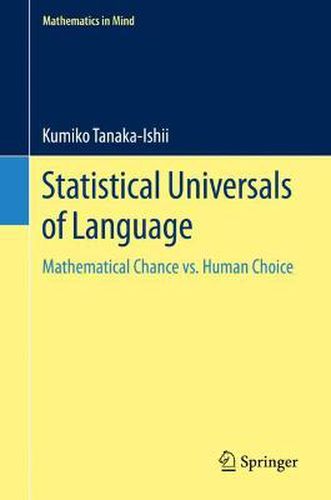Readings Newsletter
Become a Readings Member to make your shopping experience even easier.
Sign in or sign up for free!
You’re not far away from qualifying for FREE standard shipping within Australia
You’ve qualified for FREE standard shipping within Australia
The cart is loading…






This title is printed to order. This book may have been self-published. If so, we cannot guarantee the quality of the content. In the main most books will have gone through the editing process however some may not. We therefore suggest that you be aware of this before ordering this book. If in doubt check either the author or publisher’s details as we are unable to accept any returns unless they are faulty. Please contact us if you have any questions.
This volume explores the universal mathematical properties underlying big language data and possible reasons why such properties exist, revealing how we may be unconsciously mathematical in our language use. These properties are statistical and thus different from linguistic universals that contribute to describing the variation of human languages, and they can only be identified over a large accumulation of usages. The book provides an overview of state-of-the art findings on these statistical universals and reconsiders the nature of language accordingly, with Zipf’s law as a well-known example. The main focus of the book further lies in explaining the property of long memory, which was discovered and studied more recently by borrowing concepts from complex systems theory. The statistical universals not only possibly lie as the precursor of language system formation, but they also highlight the qualities of language that remain weak points in today’s machine learning. In summary, this book provides an overview of language’s global properties. It will be of interest to anyone engaged in fields related to language and computing or statistical analysis methods, with an emphasis on researchers and students in computational linguistics and natural language processing. While the book does apply mathematical concepts, all possible effort has been made to speak to a non-mathematical audience as well by communicating mathematical content intuitively, with concise examples taken from real texts.
$9.00 standard shipping within Australia
FREE standard shipping within Australia for orders over $100.00
Express & International shipping calculated at checkout
This title is printed to order. This book may have been self-published. If so, we cannot guarantee the quality of the content. In the main most books will have gone through the editing process however some may not. We therefore suggest that you be aware of this before ordering this book. If in doubt check either the author or publisher’s details as we are unable to accept any returns unless they are faulty. Please contact us if you have any questions.
This volume explores the universal mathematical properties underlying big language data and possible reasons why such properties exist, revealing how we may be unconsciously mathematical in our language use. These properties are statistical and thus different from linguistic universals that contribute to describing the variation of human languages, and they can only be identified over a large accumulation of usages. The book provides an overview of state-of-the art findings on these statistical universals and reconsiders the nature of language accordingly, with Zipf’s law as a well-known example. The main focus of the book further lies in explaining the property of long memory, which was discovered and studied more recently by borrowing concepts from complex systems theory. The statistical universals not only possibly lie as the precursor of language system formation, but they also highlight the qualities of language that remain weak points in today’s machine learning. In summary, this book provides an overview of language’s global properties. It will be of interest to anyone engaged in fields related to language and computing or statistical analysis methods, with an emphasis on researchers and students in computational linguistics and natural language processing. While the book does apply mathematical concepts, all possible effort has been made to speak to a non-mathematical audience as well by communicating mathematical content intuitively, with concise examples taken from real texts.